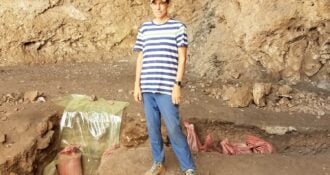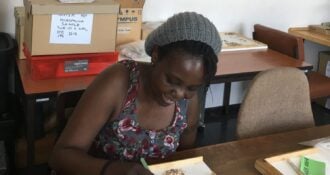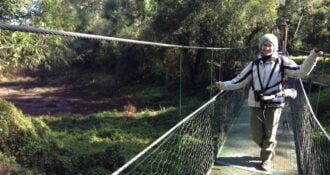
May 2014 (dry season): Geladas come off the cliffs, where they sleep at night, and regroup at the top. They often take an hour or so to socialize and rest before heading off to forage. Pictured (left to right): graduate student Morgan Gustison; field assistant Esheti; field manager Megan Gomery. Photo by E. Tinsley Johnson.
In the spring of 2013 Elizabeth Tinsley Johnson, PhD candidate from the University of Michigan, was awarded a Leakey Foundation research grant for her project entitled “A test of the vocal grooming hypothesis in the gelada.”
Geladas (close relatives of baboons) are exceptionally unique primates that are only found in the highlands of Ethiopia. What makes them unique? First, they are the only primates in the world that eat primarily grass, which means they spend a lot of time foraging – which sometimes comes at the expense of socializing. Maintaining social bonds is a critical part of gelada life, because they live in large, complex social groups. For females, in particular, the ability to maintain ties with other females in their unit is crucial for maintaining unit cohesion. Geladas are also unique in that they are exceptionally vocal primates, leading some researchers to speculate that the function of their constant chatter is to make up for lost grooming time. If true, the so-called ‘Vocal Grooming Hypothesis’ (e.g., Dunbar 1996) carries implications for how, and why, human language evolved.

May 2014 (dry season): A close-up of a family unit grooming (and playing) in the morning. Females spend roughly 20% of their waking hours grooming one another, a behavior that is critical to forming and maintaining social bonds with other members of their unit. Photo by E. Tinsley Johnson.
For the last year (Oct. 2013-Oct. 2014), graduate student Elizabeth Tinsley Johnson has been studying geladas in the Simien Mountains National Park, Ethiopia. Her research aims to understand how female geladas maintain social bonds and the potential benefits these relationships carry. In particular, Tinsley Johnson is interested in the potential role that vocal contact plays in navigating social relationships. To this end, she has collected climatological, demographic, behavioral, and hormonal data on ~45 adult females across 12 social units. Now back at the University of Michigan, Tinsley Johnson will spend the next year analyzing her data and presenting her results to professional conferences and in journal publications.

July 2014 (rainy season): A large band of geladas spends the last minutes of daylight foraging before heading back down to the safety of the cliffs to sleep. Photo by E. Tinsley Johnson.

September 2014 (rainy season): Researchers from the University of Michigan’s Gelada Research Project wait at the top of a sleep site for the geladas to come up for the day. Photo by E. Tinsley Johnson.

September 2014 (rainy season): Graduate student Elizabeth Tinsley Johnson recording the behaviors and vocalizations of female geladas as the band forages during the day. Photo by J. C. Beehner.






Comments 0